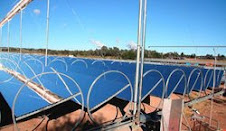Tidal turbine to be installed in Northern Ireland
BRISTOL, England, January 23, 2006 (Refocus Weekly) Regulators in Northern Ireland have approved the installation of a 1 MW tidal energy turbine.
The Environment & Heritage Service has given consent to Marine Current Turbines of England to install its SeaGen tidal turbine in Strangford Lough. The device has received £4.3 million in funding from the British Department of Trade & Industry, and builds on the earlier development of the 300 kW SeaFlow that has been operational for more than two years.
The turbine will be installed and connected to the national grid this year, and has the capacity to generate green power for 600 homes.
“This is a tremendous step forward for tidal energy technology,” says Martin Wright of Marine Current Turbines. “Given the support of DTI and Northern Ireland ministers for the SeaGen project, we now have a unique opportunity to comprehensively assess the environmental impact of our technology as well as showcase the commercial potential of tidal stream energy.”
“We are confident that SeaGen will not only prove to be genuinely low in impact and sustainable, but will show that tidal energy can become a commercial reality and will be able to contribute to the UK energy requirements sooner that expected,” he adds. “The great advantage with tidal power is its predictability, certainty of fuel supply, and zero carbon emissions.”
“The UK leads the world in the field of tidal energy and this announcement is a very important step in maintaining that position,” says energy minister Malcolm Wicks. “The Strangford location, together with the expertise of Queens University of Belfast
who will manage the monitoring program, will afford a unique opportunity to further our understanding of the true environmental impact as well as the generation potential of these new technologies.”
“It is a real feather in the cap for Northern Ireland to be at the forefront of developing the technology to commercial scale,” he adds. “Last month, my department published the consent process that is required to get marine renewable energy prototypes in English and Welsh waters, as well as highlighting the £50 million package of financial support that is available from the deployment fund. Projects like SeaGen are exactly the type of scheme we have to replicate in order to develop a world class UK industry.”
“Our work with a smaller tidal device, the 300 kW SeaFlow that was also supported by the DTI and has been running off the north Devon coast for the past two and a half years, has been invaluable in developing SeaGen, the next generation device,” says Peter Fraenkel of MCT. “We have shown that it is possible to generate power in a hostile marine environment and to have a negligible effect on marine life.”
“Strangford Lough has one of the strongest tidal currents in the UK and Ireland so is a perfect location for us to pilot a pre-commercial device,” says Martin Wright of MCT. “It’s also a fantastic opportunity for Northern Ireland to show to the rest of the world that it is serious about renewable energy and sustainability.”
MCT and Royal Haskoning conducted a comprehensive environmental assessment for the SeaGen installation, to respect the sensitivity of the location. Environment & Heritage Service granted consent via the Food & Environment Protection Act, and the developers worked with EHS and conservation groups to agree on an adaptive approach to environmental monitoring of SeaGen’s installation and operation.
Last month, EDF Energy, one of the largest energy companies in Britain, increased its investment in MCT by £2 million, to support commercial development of the 1 MW SeaGen.
“We made our original investment in MCT in 2002 and are very pleased to have extended our involvement and to be associated with the world-leading tidal energy company,” says Chris Daniels of EDF. “It is the next step in our long-term commitment to maintaining a diverse and sustainable energy mix in the future including all types of generation, clean coal, gas, nuclear and renewables. We believe this diversity is crucial to address climate change, ensure security of supply and providing competitively priced electricity for customers.”
The 300 kW SeaFlow prototype was the world’s first offshore tidal turbine when it was installed off Lynmouth, Devon in May, 2003.
MCT has established a subsidiary, Sea Generation, to advance the SeaGen project. Officials expect to see the first commercial tidal farm to be operating within the next five years.
Best Green Stocks Investing Blog
Thursday, January 26, 2006
Subscribe to:
Post Comments (Atom)
Yuya Joe Blog
Lake Ontario Waterkeeper
The Daily Beast -Politics Blog
21stArch.com - 21st Century Architecture
Original Joe College Blog
WikiLeaks Foreign Policy Analysis
AGreenRealtor.com Real Estate Blog - Ecology Energy Efficiency
Best Green Stocks Investing Blog
PV Intell Photovoltaic Solar Stocks Investing
SEARCH Leading Alternative Energy and Ethical Investing websites

Custom Search
Daily Kos
Rare Earth Stocks Research
Patrick MacManus's Blog Peace and Collaborative Development
BeesTreesFrogsElephants.com - Nature and Ecology Blog
Research Green Energy stocks, Clean Energy investing information
Find wind power investing info online, clean energy mutual funds, geothermal stocks, solar energy investments.

Green Energy Investing Network:
Green Stocks Investing Clean Power Blog
SolarIntell.com Renewable Power Investing Website
Wind Intell.com Wind Energy Stocks Company Links
Geothermal Power Investing Public Companies
PV Intell.com Leading Photovoltaic Solar Energy Stocks

Custom Search
Green Energy Investing Network:
Green Stocks Investing Clean Power Blog
SolarIntell.com Renewable Power Investing Website
Wind Intell.com Wind Energy Stocks Company Links
Geothermal Power Investing Public Companies
PV Intell.com Leading Photovoltaic Solar Energy Stocks







No comments:
Post a Comment